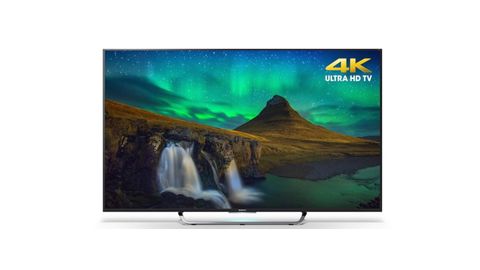Why you can trust TechRadar
Sony is for my money the most consistently strong handler of LCD TV backlighting right now - at least where edge-based lighting is involved. And happily this talent is in most ways abundantly on show with the 65X8505C.
So long as you're careful how you set the TV up anyway.
Particularly impressive is the uniformity of the 65X8505C's black level performance. Even where a mostly black shot contains a bright object in its centre the 65X8505C manages to deliver the dark parts of the image with barely a trace of light clouding, even in the image's corners.
What's more, the backlight uniformity is delivered alongside some really impressive black level depth by LCD TV standards.

Tweak the backlight setting down to around its 30 level and make sure you've got the set's Adaptive Contrast feature engaged and there's only minimal sign of greyness to take the edge off the screen's black colour.
Good dynamics - by edge LCD standards
It has to be said that with the picture calibrated to maximise its black level performance, bright elements of dark pictures don't look as punchy and light as they do on the 75X9405C - which is to be expected given the shift to edge LED lighting from direct LED lighting.
But by edge LED standards the combination of darkness and light the 65X8505C achieves is actually pretty impressive - especially given the evenness of the darkness surrounding the bright bits.
The 65X8505C also delivers a premium colour performance.
Saturations look rich and bold, yet this eye-catching dynamism comes with zero compromise in terms of tonal subtlety and finesse. On the contrary, the 65X8505C combines its native 4K resolution with some of the most exquisitely nuanced colours I've seen at this price level, and in doing so really makes all those extra pixels sing.
What's more, the 65X8505C's sense of detail and colour continues to impress when you switch from native 4K content to upscaled HD, really highlighting the quality of the X1 engine that's behind the upscaling process.
Your flexible friend
Also very likeable about the 65X8505C's colour handling is its flexibility.
It's capable of adapting its colour approach to suit pretty much any taste, from Rec709 purists right through to the new ultra-wide BT2020 system proposed as a colour 'container' for new Ultra HD Blu-ray and HDR feeds.
The BT2020 option is perhaps a bit of an oddity given the set's lack of HDR compatibility, but I'd certainly recommend that you experiment with Sony's LiveColor feature, as this can increase the sense of colour saturation - and thus make use of more of the TV's colour potential - without leading to unnatural or unbalanced tones.
So long as you avoid LiveColor's highest setting of 'power', at any rate.
I noted earlier the 65X8505C is exceptionally good at unlocking the full sharpness and detail potential of 4K content, but it's worth coming back to this point. The impact 4K UHD has on a screen as large as 65-inches, when joined by processing as astute as that employed here, really does leave you in no doubt about 4K's advantages over HD.
As well as more detail and more colour subtlety, you also get a much enhanced sense of depth with large-scale images - so much so that some shots feel almost three dimensional without the need for any glasses.

Motion clarity
It's great to see, too, that the 65X8505C is able to retain most of its sense of exceptional sharpness even when it's asked to deal with a lot of motion in the frame.
There's a little judder to be seen over large objects during camera pans, but it's not excessive - especially if you're prepared to try one of the relatively low-powered Motionflow settings (the higher ones cause the picture to exhibit processing artefacts).
While the 65X8505C mostly continues Sony's run of form where 4K UHD picture quality is concerned, though, there are a few issues to cover.
First and worst, Sony's usual deft touch when it comes to always ensuring pictures look natural and engaging seems to have escaped it a little when it comes to the 65X8505C's upscaling.
For using the TV's out of the box sharpness and Reality Creation settings upscaled pictures tend to look a bit over sharp, resulting in a tendency to exaggerate grain or source noise to uncomfortable levels.
4K should increase immersion...
I understand the motivation to try and make sure that people always feel aware that they've bought a 4K UHD TV even when watching HD content (which most current users will spend the majority of their time doing, of course).
But this motivation shouldn't go so far that it actually makes the 4K effect feel distracting.
To be fair to Sony, the effect isn't too bad if you leave on the TV's noise reduction routines - perhaps because Sony's latest processing engine is designed to work as a 'total package', with all of its different elements working in tandem.
But the notion of applying noise reduction to good quality HD sources doesn't sit comfortably with me, as it can pretty much always play a part in such images not looking as natural was they should.
I personally got the best overall impact from the upscaling engine if I reduced the sharpness setting to around its mid 40s level and the Resolution element of the Reality Creation system to around 30 from its 60 default.
The flasher
Another issue is with Sony's usually dependable backlight controls.
As I would have expected I got the best results by activating the set's adaptive backlight control system, which adjusts the TV's settings in response to the image content being shown. Without this feature turned on dark scenes tend to be affected by a little more greyness than I wanted to see.
However, it was also noticeable that the adaptive backlight feature could cause some fairly distracting jumps in the image's lighting levels whenever there was a fade to black or a jump from an almost black shot to a bright one.
The backlight appears to shut off for the darkest images before reactivating with a pronounced pulse when light comes back into the picture.
A couple of other relatively minor 2D issues are a reduction in the image's brightness in its corners, which can become noticeable while watching very bright material; a fairly limited viewing angle which finds colours starting to wane once you find yourself no more than around 25-30 degrees down the TV's sides; and a little loss of shadow detail in the image's very darkest areas.
3D issues
I mentioned 2D specifically in the previous paragraph because 3D on the 65X8505C has separate issues of its own.
First, HD 3D Blu-rays don't look as crisp or detailed as might have been expected given the 65X8505C's supremely sharp upscaling of HD 2D content.
Second, 3D images feel much less bright than 2D ones, even if you set the TV's 'glasses brightness' setting to its highest level. This lack of brightness can lead to some dark shots looking a bit hollow and flat.
The biggest problem by far, though, is crosstalk.
This double ghosting noise commonly seen with active 3D technology is both regular and pronounced on the 65X8505C, making it hard to enjoy the sort of immersive sensation 3D is supposed to deliver.
Current page: Picture Performance
Prev Page Introduction and features Next Page Usability, Sound and ValueJohn has been writing about home entertainment technology for more than two decades - an especially impressive feat considering he still claims to only be 35 years old (yeah, right). In that time he’s reviewed hundreds if not thousands of TVs, projectors and speakers, and spent frankly far too long sitting by himself in a dark room.


